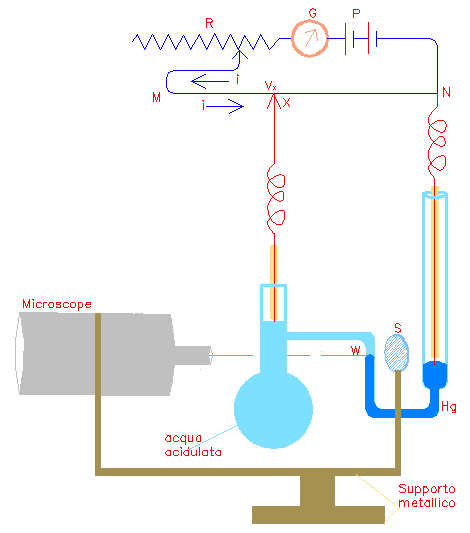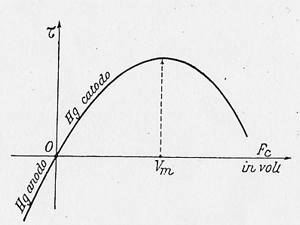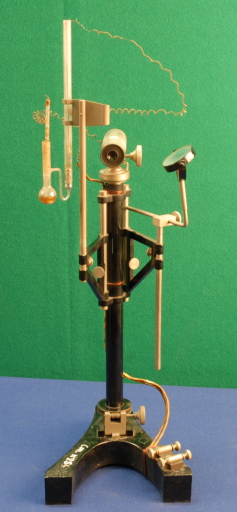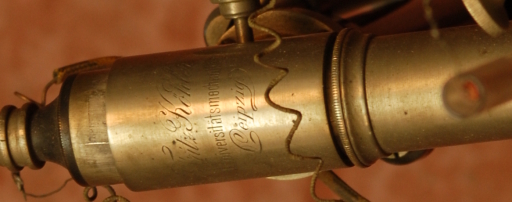» Lippmann Electrometer (0157)
Immagini




DESCRIPTION
Exhibit 157 is a very sensitive electrometer capable of revealing very small voltage differences of the order of 0.0001 volt. The mechanism employed is based on electrocapillarity, a phenomenon for which a difference of potential between two electrodes in liquids (mercury and diluted sulfuric acid) determine a variation of the surface tension at the contact surface between the two liquids which do not mix. The instrument consists of:-
Two glass containers connected by a capillary tube, one containing mercury, the other sulfuric acid (soluzione di
![Formula: [\rm H_2 SO_4] Formula: [\rm H_2 SO_4]](/foto/equaz/157_fr01.png) )
in which the two liquids are in contact at the point W inside the capillary (see design 1)
)
in which the two liquids are in contact at the point W inside the capillary (see design 1)
- Two electrodes fused in the glass containers in contact with the liquids and connected to an electric circuit constituted by a battery in series with a variable resistance and a potentiometer and including a galvanometer.
- A microscope and a mirror for reading the level at which the point W reaches equilibrium.
Phenomenologically one considers the separation between the two liquids as a two plate condenser, the energy of which is thus equal to ![Formula: [\rm \frac{1}{2}CV^2] Formula: [\rm \frac{1}{2}CV^2]](/foto/equaz/157_fr02.png) where C is the capacity of the condenser and V the difference of potential between the plates. It follows that the surface energy S is diminished by a value equal to the energy stored in the condenser, that is
where C is the capacity of the condenser and V the difference of potential between the plates. It follows that the surface energy S is diminished by a value equal to the energy stored in the condenser, that is
![Equazione: [\rm S=S_0 - \frac{1}{2}CV^2] Equazione: [\rm S=S_0 - \frac{1}{2}CV^2]](/foto/equaz/157_eq01.png)
where ![Formula: [\rm S_0] Formula: [\rm S_0]](/foto/equaz/157_fr03.png) is the surface energy at zero potential difference. Given that surface tension is an energy per unit area, there is an analogous parabolic behavior with potential difference at the electrodes found in the measurement effected.
is the surface energy at zero potential difference. Given that surface tension is an energy per unit area, there is an analogous parabolic behavior with potential difference at the electrodes found in the measurement effected.
ISCRIZIONI
- Incisione sul microscopio: "Fritz Kohler, Universitatsmechanic, Leipzig"
BIBLIOGRAPHY
- [1] Castagnoli Carlo, "Fisica Generale: meccanica - termodinamica", Levrotto & Bella , Torino. Pagina 467
- [2] Perucca Eligio, "Fisica Generale", UTET, Torino, 1963. Pag, 677
- [3] Worsnop & Flint, "Advanced Practical Physics For Students",Asian edition,1961, pag.585.
- [4] P. Fleury, J.P.Mathieu, "Elettrostatica Corrente continua Magnetismo", Zanichelli Bologna, seconda edizione, 1970. §20-15,Pagina 489.
Dati Catalografici
| Data di costruzione: | --- |
|---|---|
| Data di carico: | 31-10-1904 |
| Nr. Inventario: | 254 Cons. (Consorzio Univ. di Torino) |
| Costruttore: | Fritz Kohler |
| Materiale: | metallo, rame, vetro, mercurio |
| Dimensioni: | 15 cm x 17,5 cm x 36 cm |
| Conservazione: | buono |
